|
|
 "QUANTUM SHOT" #475 "QUANTUM SHOT" #475
Link - article by M. Christian and Avi Abrams
Flying on Gigantic Wings
Fulfilling numerous requests from our readers, here is a page documenting the history of huge airplanes, in a visually striking and wondrous manner...
For a few thousand years the biggest things in the skies were only in our imaginations, flying figments of myth and fable: the Roc from Sinbad’s tales, the Garuda bird from the Mahabharata, the Thunderbird from North America, the Brazilian Blue Crow, and other high-flying nightmares or soaring benevolent gods and spirits.
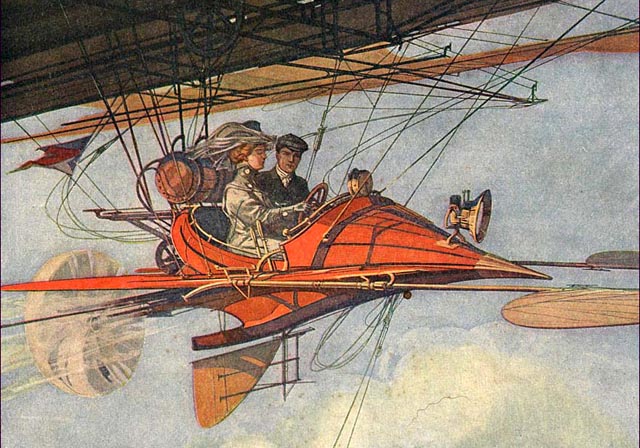
(art by Harry Grant Dart, All-Story ca. 1900)
But then a few very clever, and rather persistent, folks got tired of only dreaming. With great inventiveness, they wanted to see what was actually above the clouds. They sought to create something as wondrously big, or nightmarishly immense, as those birds of myth and legend.
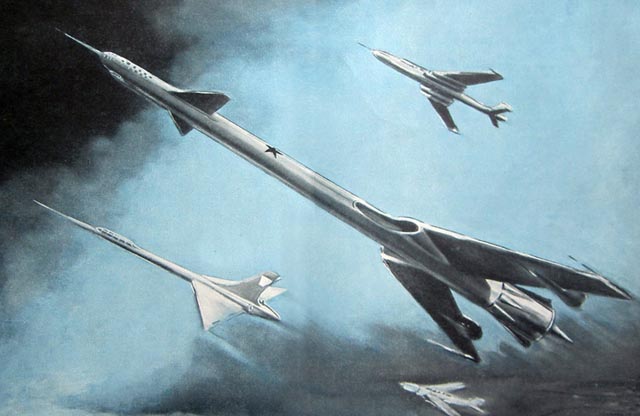
(image credit: retro-futurismus)
Talking about big planes is very much like talking about who should get the credit for man’s first flight –- it all depends on who you talk to. As the brilliant James Burke has pointed out, inventors rarely create something from nothing –- their successes are often the result of combining the partial successes, or learning from the downright failures, of other inventors. In some cases, it's just pure dumb luck.
Sputtering, Creaking, Terrifying Monsters
The Wright Brothers are often given most of the recognition for the first powered flight but Gustave Whitehead, Alexander Feodorovich Mozhaiski, Clement Ader, and many others should get a share of the fame, too. Whoever is responsible, it wasn’t long before the skies were full of sputtering, creaking, and – for the most part – very unreliable aeronautical devices.
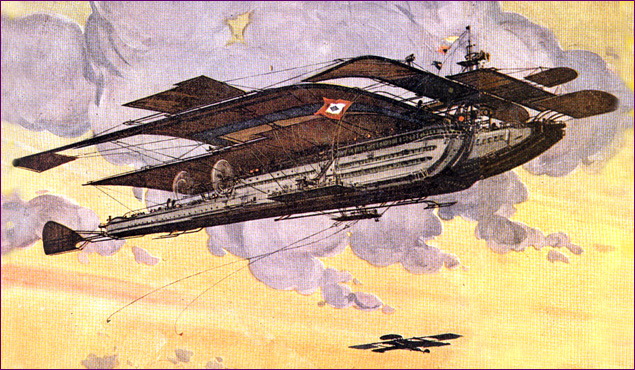
(futuristic art by Harry Grant Dart)
It took the first world war to change aircraft from a killing and maiming hobby for the rich to a killing and maiming war machine. War helped advance the science of flight and necessitated bigger planes.
One monster plane of that time was Igor Sikorsky's Ilya Murometz, a huge improvement over his legendary Russky Vitaz, the first four engine aircraft. But the Ilya Murometz didn't begin as a beast of the skies. Originally designed as a luxurious passenger liner featuring electric lighting, heat, a bathroom, and even a glass floor, the bomber must have been amusing as well as terrifying to its wealthy passengers.
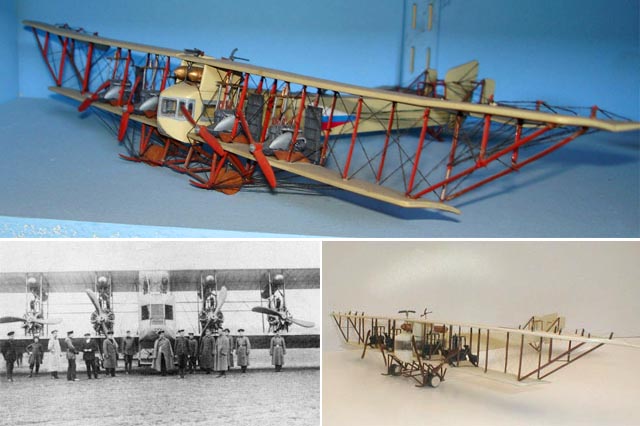
(images credit: histarmar.com.ar)
Another iteration of such approach was Tupolev ANT-20 "Maxim Gorky":
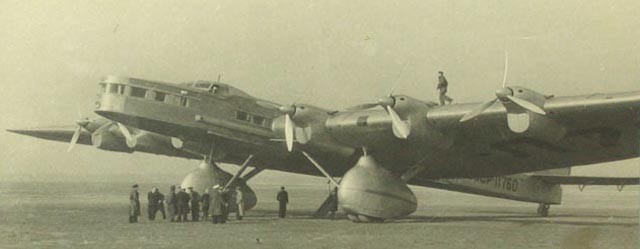
And a really huge Russian monster plane from the early 1930s: Ka-7 (more info), named after engineer Kalinin, not the famous political figure.
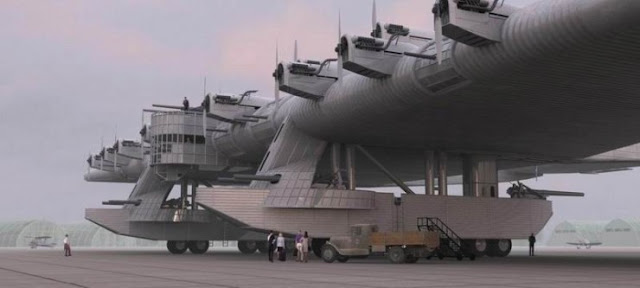
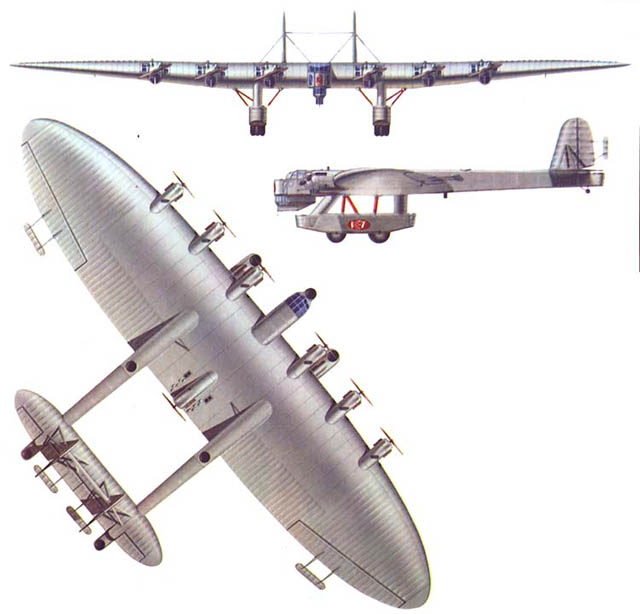
(images via Modelist-Konstruktor, 1989)
A lot more images of highly souped-up imaginary version of this monster can be seen here, and it's definitely worth a click...
Art and Elegance Between Wars
In the years between wars, airplanes kept getting bigger. Outrageous concepts like Norman Bel Geddes Airliner Number 4 appeared, featuring 9 decks of luxury hotel accommodation, bars and engine rooms:


It would sleep 606 passenger in comfort, easily bringing them across Atlantic. More images and info about Bel Geddes fantastic dream planes are here. It seems to be a logical development of 1910s British Airliner of the Future:
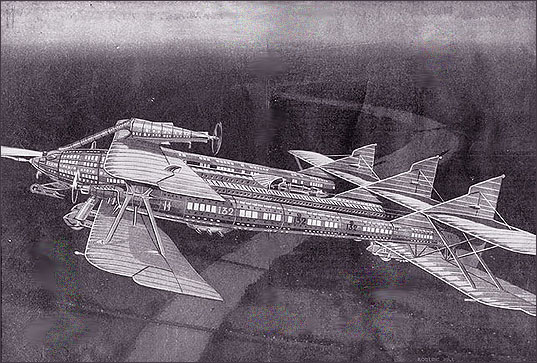
(image via)
Don't miss also this "Freak of the Month" concept from Modern Mechanics, 1931:
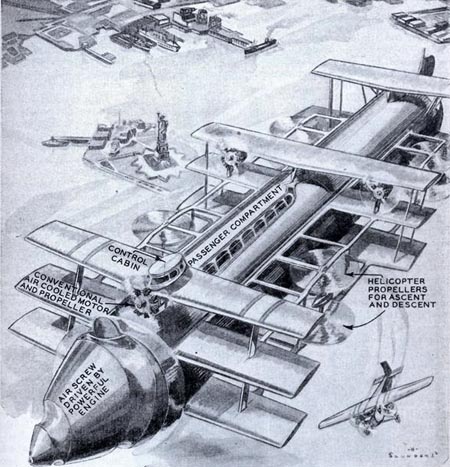
(image credit: modernmechanix)
But let us get back from aviation dreams to reality. Take the elegant Handley Page HP42, for instance: a four-engined beauty with an impressive track record of no crashes while being used as an airliner -- which gives you an idea of how safe it was to fly back then.
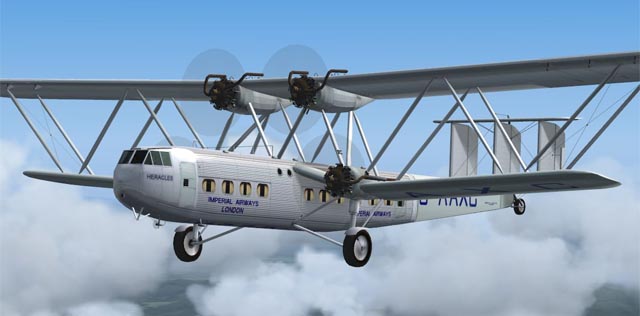
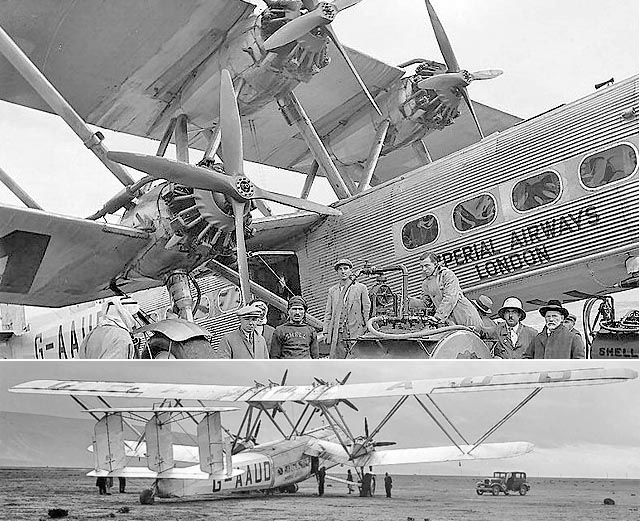
(images via)
One of the larger and more beautiful aircraft in the next few decades was the awesome 1936 Boeing Stratoliner. Unfairly called a ‘whale’ because of its chubbiness, the plane was not only huge but also state of the art; today we enjoy flying in pressurized comfort because of technology premiered in the silver flying fish of the Stratoliner.
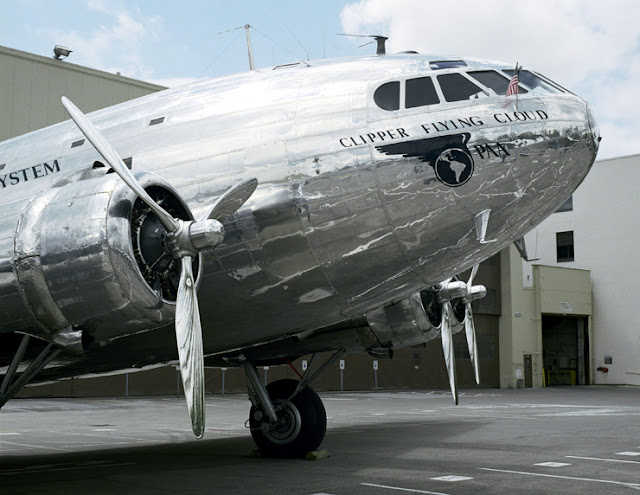
Another aircraft both immense and legendary - The H-4 Hercules. Arguably the standard by which “huge aircraft” are measured –- as well as how "completely screwed up" is defined. Its one and only flight was in 1947, where it flew for around a mile, reaching altitude of 70 feet. Originally planned as the ultimate military transport, it is more commonly known as its hated -- at least by its creator Howard Hughes -- moniker, the Spruce Goose.
The aircraft had originally been ordered by the US government during World War II as a giant cargo plane for the armed troops and tanks. Howard Hughes's creation was the world's largest plane at the time and is still the largest flying boat ever built. It also holds records for the largest wingspan at 97.5 meters, tallest airplane at 24.2 meters, and the largest aircraft ever made from wood.
Nazi's Ugly Brute
Art and elegance may have been one of the early fatalities in the second world war, but striving to have the biggest (anything) certainly wasn’t.
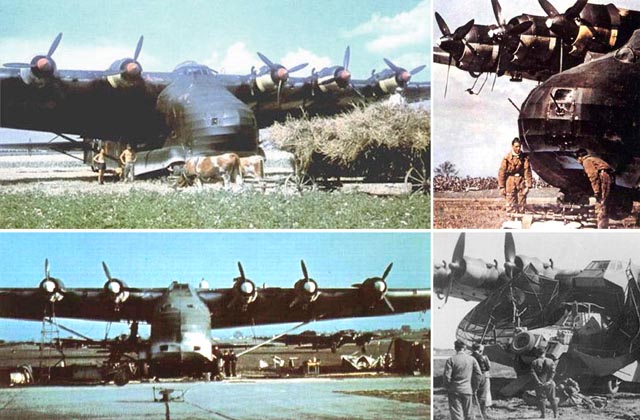
To call the Messerschmitt Me 321 big is like calling 1939 to 1945 unpleasant. Created originally as a glider, the Gigant could haul an insanely large amount of cargo. And an insane bunch of soldiers: 130 plus hardware ... 23 tons of hardware.
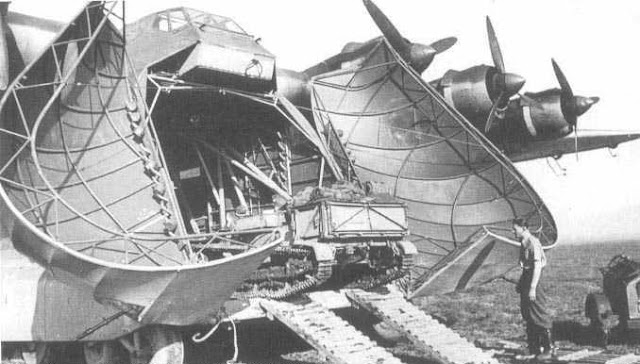
(images via)
Because the Gigant was so huge, getting the damned thing into the air was, at best, problematic. First it was towed up with a pair of Heinkel 111 bombers, which was alternatively unsuccessful or disastrous. Then they tried fusing two 111s together to make a Frankenstein’s monster of a machine –- almost as bestial as the Gigant itself. Finally the Luftwaffe stuck engines on the Me321, which made an ugly brute even uglier but at least it got off the ground.
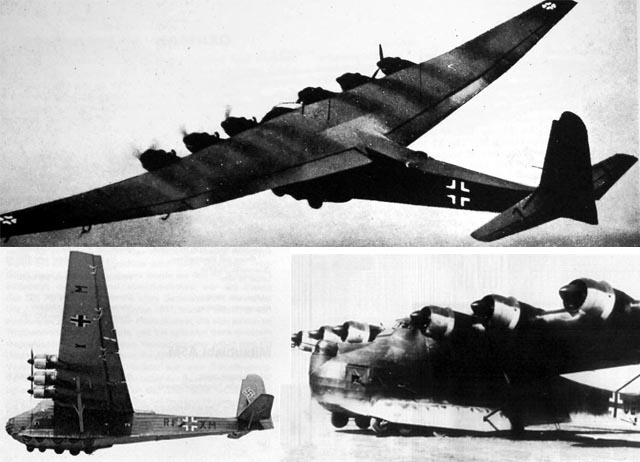
Heavy Bombers of the (Potential) Doomsday
On the other side of the war was an eagle, a silvery steel bird of prey: the huge and beautiful B-29 Superfortress. Although getting the immense B-29 up to its ceiling of 40,000 feet was a struggle, once it got up there nothing could reach it or, at 350 mph, catch it. Even if something managed to come close to it, its formidable defenses could cut any threat to shreds. Featuring many impressive advancements, and some frustrating problems, the plane was kept on active duty long into the Korean war.
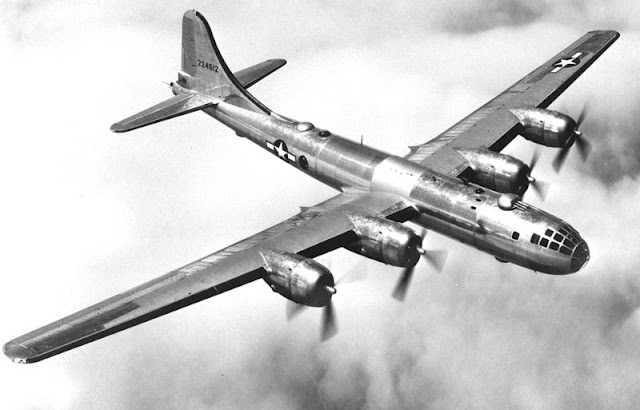
(image via)
With the advent of jet power, aircraft designers began to think really big. Think of your average doomsday film and you immediately picture the roaring ascent of smoke-blasting, eight-engined, B-52 bombers. But before B-52 there was another huge American bomber: Convair B-36 "Peacemaker":
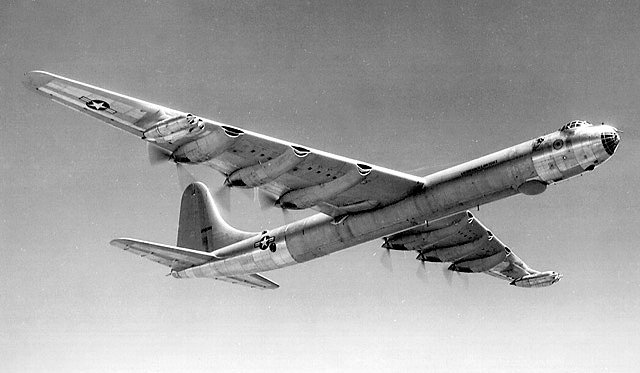
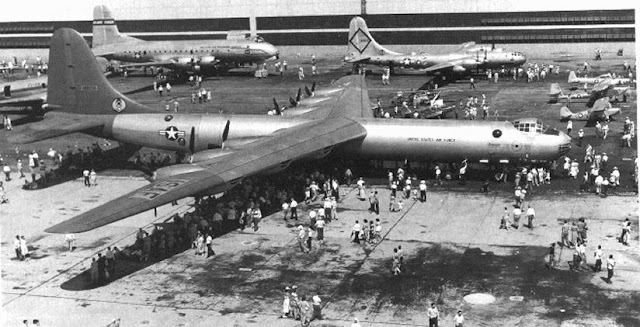
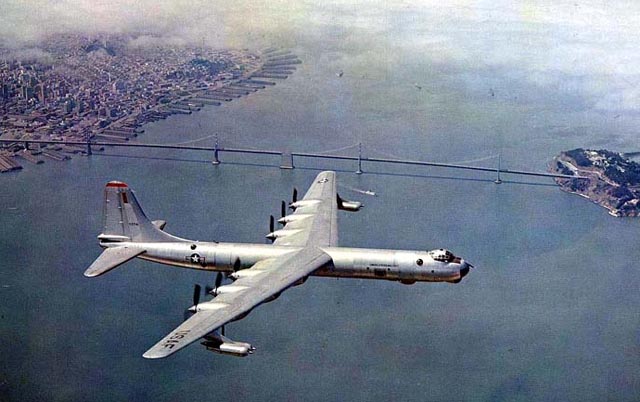
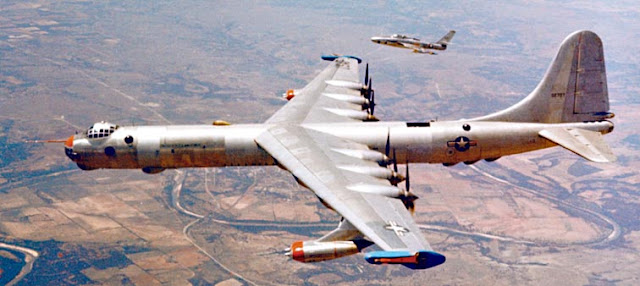
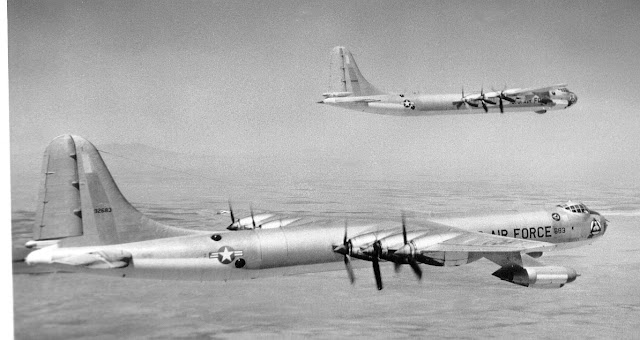
(images via)
Like the B-29, the B-52 "Stratofortress" was an aeronautical powerhouse, a heavy-lifting behemoth. And like the B-52, it was kept in service until … well, they are still being used today.
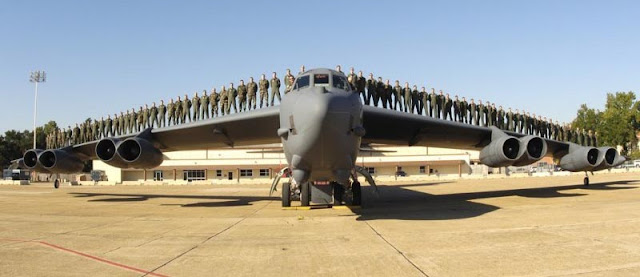
(image source: US Air Force)
Heavy bombers transforming into LEGO pieces in the minds of dazed Cold War engineers:
Arthur Kimes writes to us: "Soviets also proposed to stick together a bunch of big airplanes to make a REALLY huge one. Kind of like a Lego dream come true: In the early-mid 1950s the USAF had a plan to link 3 B-36s (wingtip to wingtip) to have a extended range delivery system. When this behemoth got close enough to the Soviet Union each would drop off a parasite fighter-bomber (probably the F-92 - which also was never built) and the released FBs would make a high-speed dash and drop a bomb on their targets. The B-36s would split up and return, the F-92s would have to try and find a friendly airfield in Turkey or something like that."
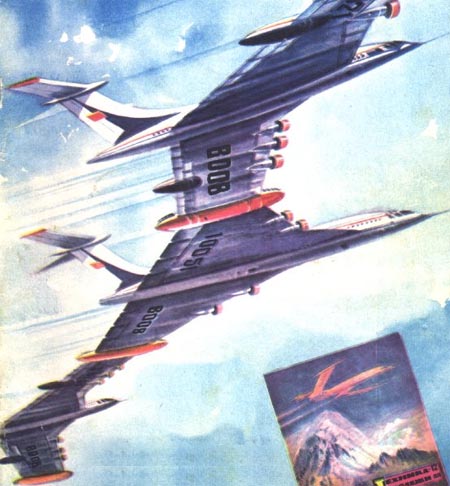
(image source: TM, 1975)
"When you consider the B-36 is still the largest bomber ever built, the idea of 3 of them flying joined at the wingtips is astounding."
The Ugliest Airplane Ever Built?
The Aero Spacelines Super Guppy looks more like a prop from a Japanese monster movie than a real airplane. The Guppy is also high on the irony meter as it was mostly used to haul nearly-completed components -- of other airplanes.

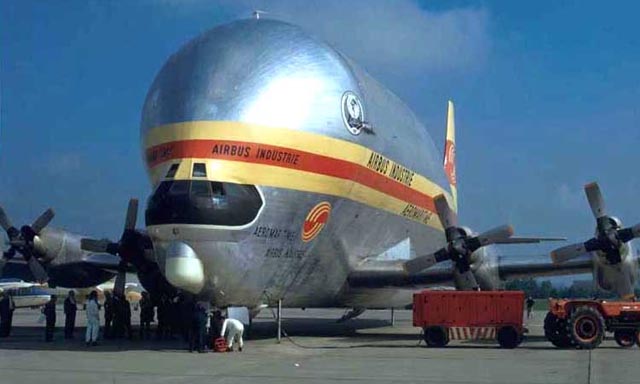
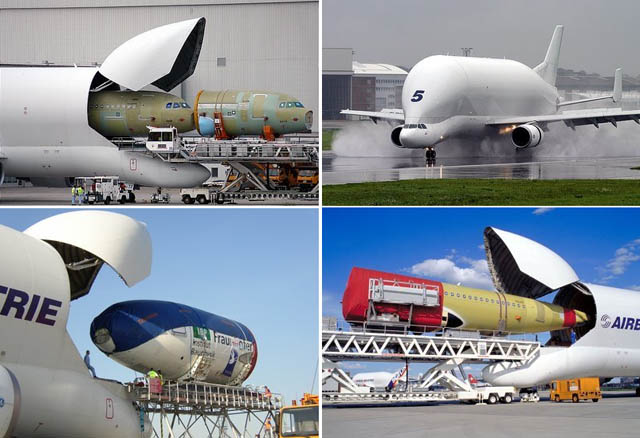
(images credit: Mischa Oordjik, Alastair T. Garoiner)
The Airbus A300-600ST (Super Transporter) or Beluga:
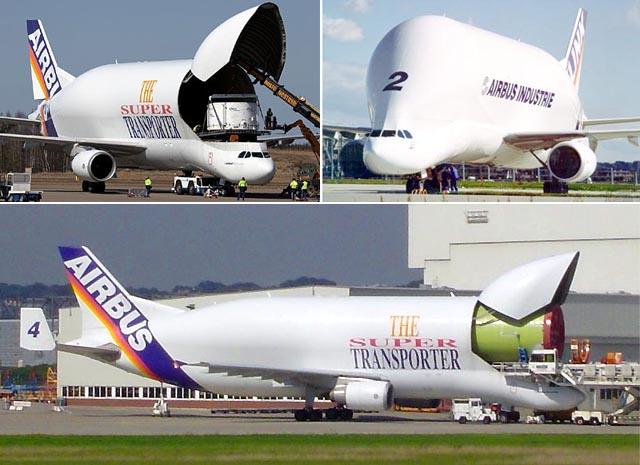
(images via)
Here is a Russian carrier VM-T "Atlant" used in a Buran and Energia space programs, which is perhaps the only airplane capable of carrying on its "shoulders" a load larger and heavier than itself:
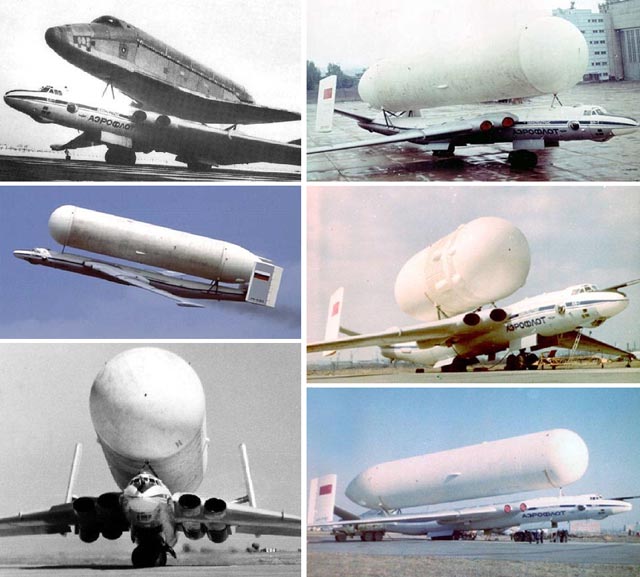
(images via)
Transporting a fuel tank for the second stage of Energia rocket:
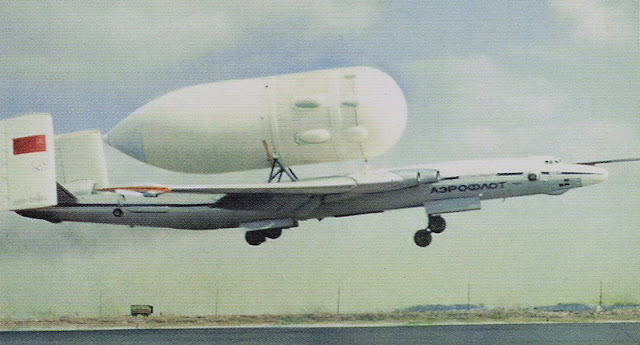
(image source: "Cosmonautics - A Colorful History" ed. by Dr. Wayne R. Matson)
Nuclear-Powered Lockheed Mothership
Nothing comes close in size to this unbelievable concept developed by Lockheed in the 1970s:
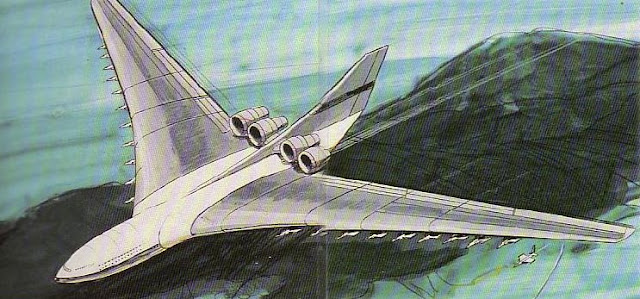
Note small "children" airplanes, attached to its wings... Its hard to imagine anything bigger flying in the skies, still retaining the shape of a common airliner. An aircraft of this size would have to land on water as a titanic "flying boat".
The Biggest Planes Flying Today
Unlike the B-29 and the B-52, which don’t show their size easily, the C-5 Galaxy would look insanely monstrous even on a postage stamp. To give you an idea of the Galaxy’s size, its wingspan is not just longer than the Wright Brothers’ first flight but the beast can also haul 180,000 pounds (which is about 90 tons). The C-5 was the world's largest plane when it was introduced in the late 1960s.

(image credit: Pervez Iqbal)
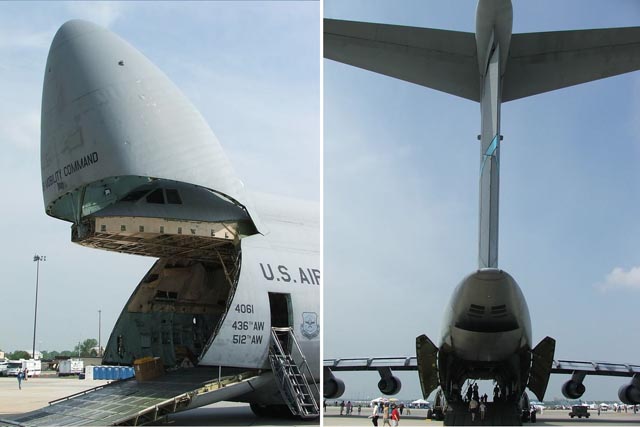
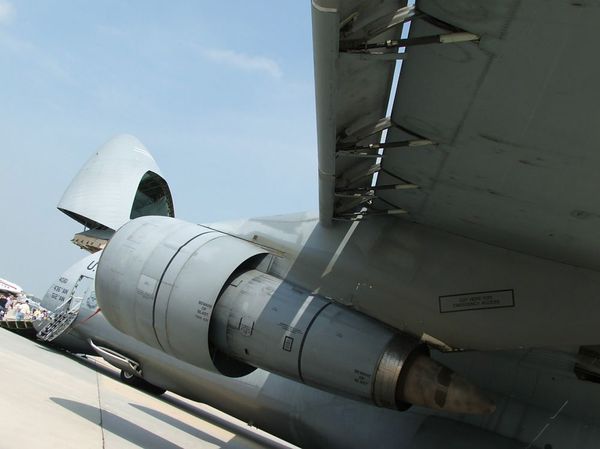
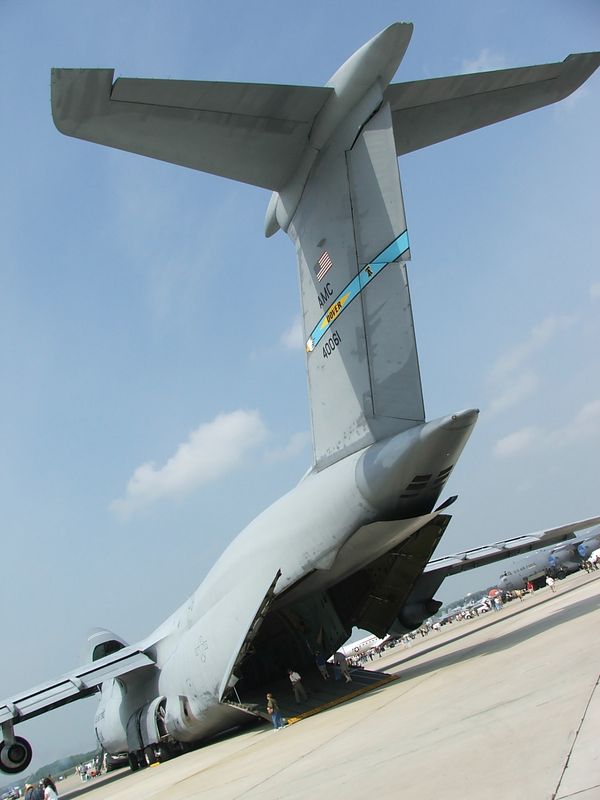
Arguably the biggest plane flying today, or ever, is Antonov An-225, a 6-engine beast that’s not only longer than the first flight in history but could probably carry one, two, or three whole aircraft museums. Numbers don’t mean much but here is an impressive one: the 225 can carry 550,000 pounds, which is 275 tons. Yes, you can say WOW.
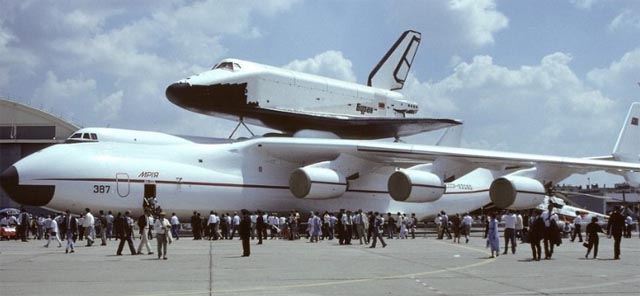
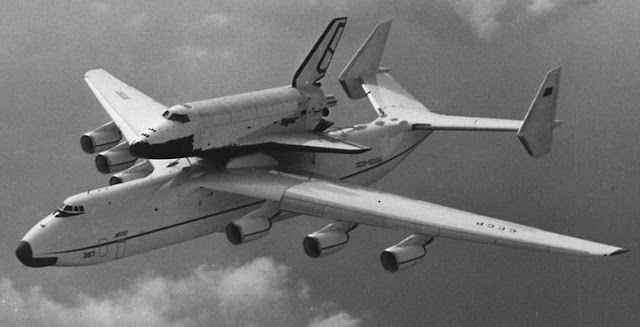
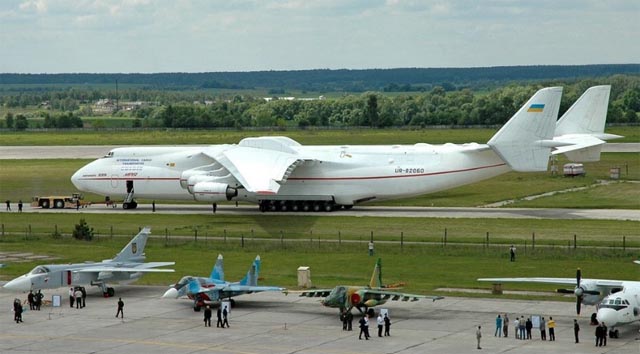

(image credit: Dmitry Pichugin)

(image credit: Radek Oneksiak)
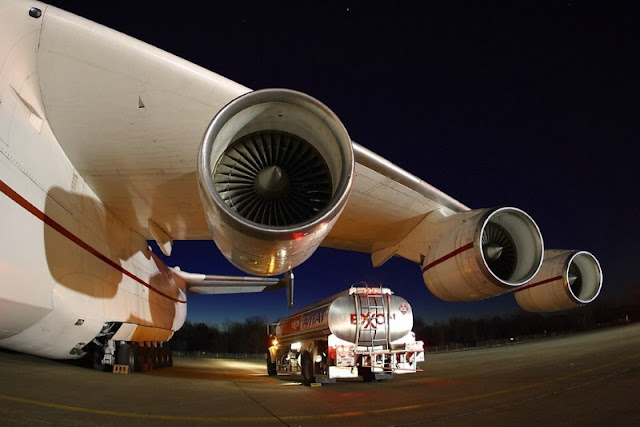
(image credit: airliners.net)
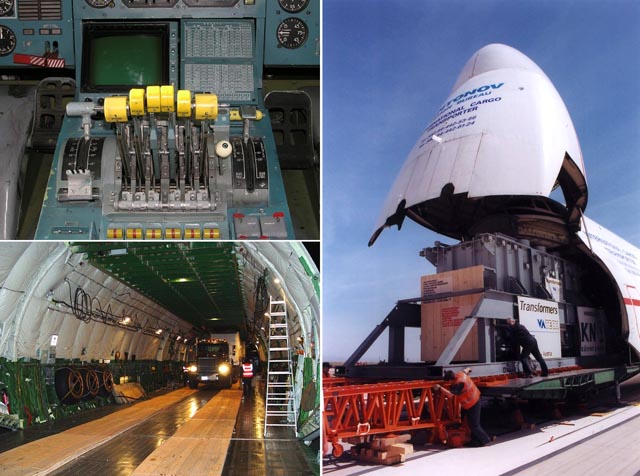
(images via)
This is a good dimension-comparison chart:

(image credit: Clem Tillier, via)
When it comes to passenger aviation, Airbus A-380 is the current leader in size: this image shows its comparative size among other planes in the airport -
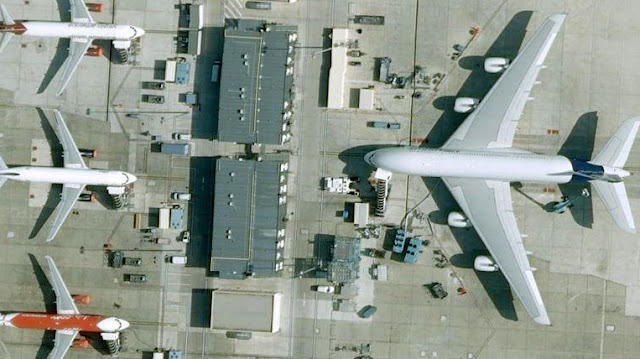
We used to have the Roc, the Garuda bird, the Thunderbird, Blue Crow, and other soaring myths. Now we have machines; airplanes so big they’re even greater than those ancient, and magnificent, dreams. Of course, there is another advantage to premium size - you can always claim your piece of the sky, and outright own the airstrip:
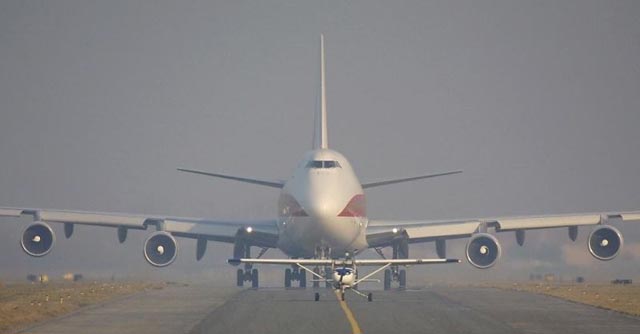
(image credit: Sven De Bevere)
Article by M. Christian and Avi Abrams, Dark Roasted Blend.
CONTINUE TO THE NEXT PART! ->
CONTINUE TO THE "HUGE HELICOPTERS"! ->
Also Read: Airship Dreams, Retro-Future: Mind-Boggling Transportation, Flying Submarines!
|
|
RECENT ARTICLES:
"Dark Roasted Blend" - All Kinds of Weird and Wonderful Things, Discovered Daily!"
DRB is a top-ranked and respected source for the best in art, travel and fascinating technology, with a highly eclectic presentation. Our in-depth articles in many categories make DRB a valued online magazine, bringing you quality info and entertainment every time you visit the site - About DRB
Connect with us and become part of DRB on Facebook and Twitter.
YOUR COMMENTS::
READ OTHER RECENT ARTICLES:
CATEGORIES:
Feel-Good! | airplanes | animals | architecture | art | auto | boats | books | cool ads | famous | futurism | food
gadgets | health | japan | internet | link latte | military | music | nature | photo | russia | steampunk
sci-fi & fantasy | signs | space | technology | trains | travel | vintage | weird | abandoned
|
|
















































































































42 Comments:
First!!!
Wow!!! A very very awesome post here on DRB!!! What about the A380 though? Is it not going to be one of the biggest planes when it becomes more common in service soon??
Antonov isn't Russian, but an Ukrainian plane. It was constructed during the Soviet Union years, though.
It should be A-380 in the text now... fixed.
Great article! Keep it up.
Grz, Godius
One you missed- Boeing have butchered a 747 in order to make something capable of carrying 787 fuselage parts- as they can' go hiring an Airbus now, can they? The thing is called the "Large Cargo Freighter" (LCF), and has a huge barrel fuselage starting about where the "bump" should go back down.
Love the article!
What was that lockheed nuclear plane called? Where can I read more about the concept?
and no pic or anything abaot the DO-X
??? DORNIER ..was the best!!!
The powered version of the Me 321 Gigant was designated the Me 323.
Note that in the Antonov An-225 landing gear picture the first tyre is bald with a little bit of canvas showing through at the base. I guess there are a few other tyres to take the strain when that one blows out ;)
Yeah, the Antonov was on the Ukranian property at the time of the split and they managed to snatch it.
Was made by Russians originally for the Buran space shuttle.
DanG! Did you notice the size of those cannons on the Russian Ka-7? Wow due that thing meant serious business.
Jiff
www.anonymize.us.tc
I wish someone would supersize my Mercury Cougar.
filthyrichmond.blogspot
the last picture is a boeing 747, not the a380.
I was always hoping for a plane that would span 20 floors/levels high, sorta an apartment complex in the air.
I guess that would have been the next step had zeppelins actually been sustainable.
Surprised you didn't include the aircraft that the An-225 was based on, the An-124. This is also bigger than the biggest US cargo aircraft, the C-5.
A few monster-sized planes left out that are also impressive:
A cargo version of the B-36 was built: the XC-99. Only one was built, and after service as a cargo carrier in the Korean War was put out to pasture. It is currently awaiting restoration at the USAF Museum.
The Martin Mars, four of which were built in the 1940s for the US Navy, were the largest flying-boats to enter service. Two are still flying, as enormous water-bombers fighting fires in British Columbia.
Along the same lines, the Saunders-Roe Princess was designed after WWII to fill a perceived need for a luxurious long-distance flying-boat passenger liner. Unfortunately, delays in construction along with the advent of more practical long-range airliners (such as the Boeing 377 Stratocruiser, based on the B-29) killed any hope of the Princess going into service.
The Bristol Brabazon was designed by the same committee that outlined the need for the Princess. This huge prop airliner, around the same size as a 747, was only built to carry about 100 passengers and was deemed economically unfeasible.
The Atlant maybe the only plane able to carry something bigger than itself, but it certainly isn't the only one to carry something heavier than itself. The PAC Cresco has a dry weight of about 1.3 tonnes, but can carry 2 tonnes of cargo off the ground.
The Spruce Goose flew for a mile, not 70 feet. 70 feet is the altitude it reached, not the distance.
The Guppy looks kind of um... hydrocephalic...
The AN-225 was actually on the ground in Philadelphia at the time of the split. It sat around for a couple of weeks waiting for a decision to be made about to where it was going to fly "home."
Eventually declared a Ukrainian ship, local Ukrainian immigrants helped set up fund raisers for the crew, including tours of the massive beast (I got inside, what a marvelous piece of engineering.)
I remember they had a Christmas tree set up in a corner of the cavernous hold. They sold souvenirs-Pins and postcards.
I have a coffee cup that says:
MRIYA
Philadelphia-Ukraine
November 15-17,1991.
Jeremy - great info, will go into Part 2
Jeff - flight length fixed
Mriya coffee cup would be something that DRB store would sell :)
The first Ka-7 pic (the one with the cannon) is obviously fake. Impressive aircraft nonetheless, had no idea it existed until I read this article. The Russian aviation museum in the link was also new to me. Thanks!
I recall attending an airshow outside of Boston. To enter the show the crowd walked through a C-5, that's a big plane. Come to think of it, it was the same day a bunch of us were crowded into the tail of a KC135 tanker when a crewman came back and asked us to slowly walk forward so the nose wheel wouldn't slam back down onto the tarmac too hard. Aircraft wheelies! Too cool.
The first Ka-7 picture is not a Ka-7, it's something much bigger, which almost certainly was never built. The ka-7had six, then in later modification, seven engines.
This monster, in cg image form, not a real photo, has at least ten engines, many more wheels, a vastly larger fuselage...
I'd be interested, though, to find the original source of that image...
Oh.. and the truck is not a soviet 1930s truck either... looks more american in origin.
i think the super guppy is kind of cute. some rich guy should turn one into a luxurious flying mansion.
I like all the aero planes, especially the old ones. There is a history covered in these pictures. I also have a great collection of my favorite jet planes and soon I will exhibit them.
Well, if some countries get off their asses and give Beriev some funding, we'll have a new king of the skies - and it'll be amphibious to boot. The Beriev Be-2500 is planned to have a 156m wingspan!! That's almost double the An-225's
In the mid 1970's, I was at an air show in Cleveland. They had a C-5A Galaxy there. To give you an idea of the size of this brute, there were three members of the aircrew standing on top of the horizontal stabilizer, flying a kite!
Good post, but why is it that people always manage to forget that the Wright Brothers WEREN'T the first to manage sustained flight, and that the first was actually Richard Pearse, only a few days earlier, or weeks perhaps, than the Wright Brothers, across the world down in a little place called NEW ZEALAND!!! Just because we're small, it doesn't mean we should be forgotten. The two flights were completely unrelated, btw.
Wowwwww..!! what an impressive collection.
Thanks for sharing this insightful view of the aviation industry, i always found it very intriguing.
There was another "monster" that is almost an aircraft. It flew, but not very high. Some of the WIG or Wing In Ground effect aircraft were huge. These Ekranoplan types were called the "Caspian Sea Monsters". http://www.globalaircraft.org/planes/lun_ekranoplan.pl
Aqui em Portugal, agora usamos expressões para expressar o quão boa uma gaja é, assim: "Olha que avião! Comi-a toda..." ou "É mema boa! É um autêntico 747..." Nesse caso acho que a Beyonce seria um A380 a Ivanka Trump o An-225 e a Lucy Pinder um C-5 Galaxy
Here is the translation of this comment from Portuguese:
"Here in Portugal, now we use words to express how good it is a girl, thus: "Look at that plane! Ate it all ..." or "It's good MEMA, it is an authentic 747 ..." In this case I think that Beyonce would be an A380 Ivanka Trump to the An-225 Lucy Pinder and a C-5 Galaxy"
Quote:
Anonymous said...
i think the super guppy is kind of cute. some rich guy should turn one into a luxurious flying mansion.
end quote.
Or a small flying Country! The rich guy would now be the president or king. And secede from his country of origin, and invite others. Just a thought.
The idea's based loosely on this.
Give it a Splat!
Awesome picks! These picks are enough to motivate some students to make the career as commercial pilot. Some flight schools also give online pilot training to the students. So, interested students can take the information and training from these sites.
GREAT post. you always post a couple of things I've never seen before.
Another aircraft I recommend checking out is the 'Tarrant Tabor'. An amazing but disasterous machine
http://en.wikipedia.org/wiki/Tarrant_Tabor
http://www.airwar.ru/image/idop/bww1/tabor/tabor-3.jpg
Aces up, Avi! Excellent stuff!
Came across this a while ago -- Saunders-Roe was approached by P&O Lines about a titanic flying boat for the London-Sydney run. SARO began designs for a 1000 passenger airliner with five decks and 24 Rolls-Royce jet engines (!!!!!!!)
http://www.abovetopsecret.com/forum/thread198736/pg1
source of the CG KA-7/K-7 rendering:
http://www.rusring.net/~levin/k7/k777.htm
FYI, the comparison chart is via Clem Tillier: http://en.wikipedia.org/wiki/User:Ctillier
The C-5 looks so blobby fat and saggy compared to the HUGE but still slick An-225, which I noted can carry over 3 times (!!) as much weight. Next time add some inside view pics with people so appreciate the ballrooms size space inside. Then add one from Beluga ;)
K-7 looked nothing like in the picture above, which (as others have already noted) is an artist's impression. I googled because I thought no aircraft can be this hideous (and the image doesn't look very 1930's)
the airbus is used by nasa, i think?
Post a Comment
<< Home